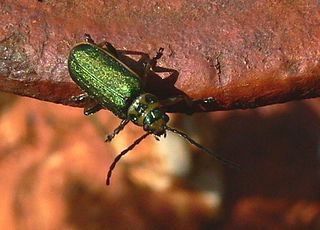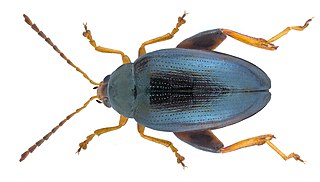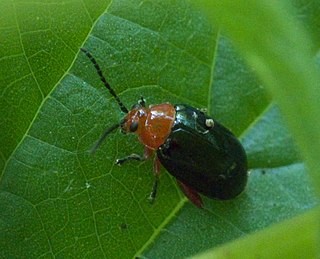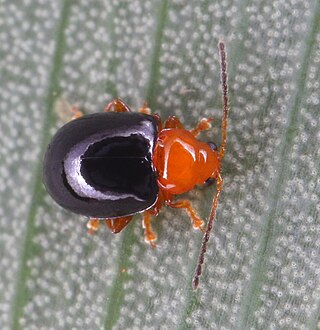
The flea beetle is a small, jumping beetle of the leaf beetle family (Chrysomelidae), that makes up the tribe Alticini which is part of the subfamily Galerucinae. Historically the flea beetles were classified as their own subfamily.

The Galerucinae are a large subfamily of the leaf beetles (Chrysomelidae), containing about 15,000 species in more than 1000 genera, of which about 500 genera and about 8000 species make up the flea beetle tribe Alticini.
Catherine N. Duckett is the Associate Dean of the School of Science at Monmouth University. Formerly she worked as Associate Director of the Office for the Promotion of Women in Science, Engineering and Mathematics, and the Program Manager of the Ocean Biogeographic Information System at Rutgers University, as well as a former Associate professor of Biology at University of Puerto Rico at Rio Piedras. She is also a prominent systematic entomologist, specializing in the phylogeny of flea beetles, and an adjunct professor at Rutgers.

Altica is a large genus of flea beetles in the subfamily Galerucinae, with about 300 species, distributed nearly worldwide. The genus is best represented in the Neotropical realm, well represented in the Nearctic and Palearctic, but occurs also in the Afrotropic, Indomalaya, and Australasia. The species are similar to each other, small metallic blue-green-bronze beetles, often distinguished from each other only by the aedeagus. The species of Altica, both as larvae and as adults, are phytophagous, feeding on plant foliage of various food plant taxa, specific for each Altica species. Onagraceae and Rosaceae are the dominant host plant families for Holarctic species. The adult Altica beetles are able to jump away when approached.
Psyllototus is an extinct genus of flea beetles described from the late Eocene Rovno amber of Ukraine, and from the Baltic amber of Russia and Denmark. It was named by Konstantin Nadein and Evgeny Perkovsky in 2010, and the type species is Psyllototus progenitor. In 2016, a newly described extant flea beetle genus from Bolivia, Chanealtica, was found to be most similar to Psyllototus, based on the characters available for observation.

The sumac flea beetle, Blepharida rhois, is most commonly found in North America and is a member of the herbivorous beetle family, Chrysomelidae. More specifically, this beetle is part of the Alticinae subfamily, a highly diverse subfamily that includes more than 1000 species in 550 genera. Members of the Chrysomelidae family are distinguished by their enlarged metafemora and their ability to jump up to 100 times their length. This gives the beetle the ability to catapult jump in order to escape approaching predators. This ability has led to the common name of “flea beetle.” Both larvae and adults are typically a quarter of an inch long. While adults are cream colored with irregular reddish patterns, larvae are typically gray with yellow stripes.

Psylliodes chrysocephala or Psylliodes chrysocephalus, commonly known as the cabbage-stem flea beetle, is a species of leaf beetle situated in the subfamily Galerucinae and the tribe Alticini.
Bikasha is a genus of flea beetles in the family Chrysomelidae. There are 19 described species from the Seychelles and the Oriental realm.
Kuschelina jacobiana is a species of flea beetle in the family Chrysomelidae. It is found in North America.

Kuschelina gibbitarsa is a species of flea beetle in the family Chrysomelidae. It is found in North America.
Systena marginalis, the margined systena, is a species of flea beetle in the family Chrysomelidae. It is found in North America.
Andersonoplatus is a genus of flightless flea beetles belonging to the family Chrysomelidae, subfamily Galerucinae. All 16 species are new to science and discovered from Venezuela and Panama.
Acallepitrix is a genus of flea beetles in the family Chrysomelidae. There are more than 20 described species in Acallepitrix. They are found in the Neotropics, Central America, and North America.

Asphaera is a genus of flea beetles in the family Chrysomelidae, containing some 130 species, found in North America, Central America, and the Neotropics.
Phyllotreta liebecki is a species of flea beetle in the family Chrysomelidae. It is found in North America.

Blepharida is a genus of leaf beetles of the subfamily Galerucinae. They have co-evolved with plants in the genus Bursera, which they feed on. The plants have developed a sticky, poisonous resin that sprays out when the leaves are bitten into, and the beetles have evolved to cut through the veins of the leaves to disable this mechanism first. There are currently 73 known species in Blepharida, which are found in the Nearctic, Neotropical, Afrotropical and southern Palearctic realms.

Podontia is a genus of flea beetles in the family Chrysomelidae. They belong in the Blepharida-group of flea beetles.

Hemipyxis is a genus of flea beetles in the family Chrysomelidae. They are found in Sub-Saharan Africa, eastern Asia, and Australasia.

Stuckenbergiana is a genus of flea beetles belonging to the family Chrysomelidae. There is a single described species, Stuckenbergiana glabrata, which is found in South Africa.










